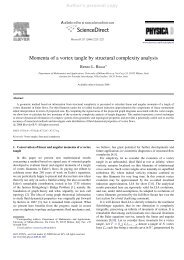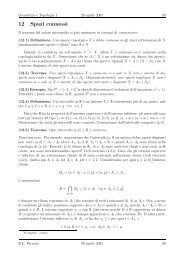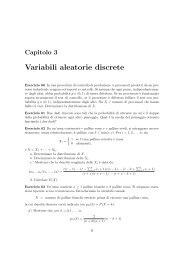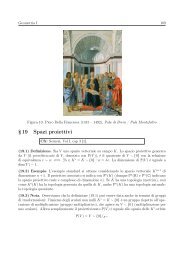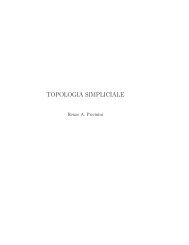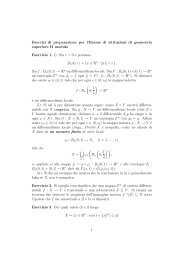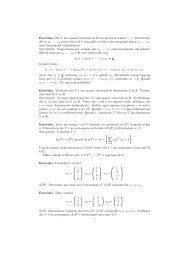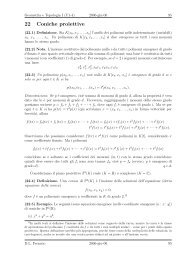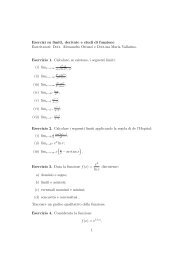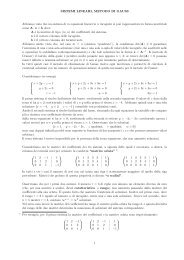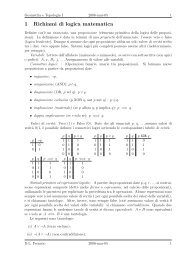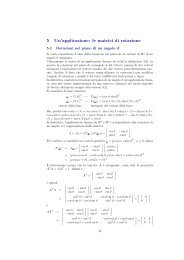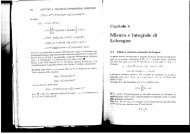7. Equazioni differenziali stocastiche - Matematica e Applicazioni
7. Equazioni differenziali stocastiche - Matematica e Applicazioni
7. Equazioni differenziali stocastiche - Matematica e Applicazioni
Create successful ePaper yourself
Turn your PDF publications into a flip-book with our unique Google optimized e-Paper software.
124 <strong>7.</strong> EQUAZIONI DIFFERENZIALI STOCASTICHE<br />
<strong>7.</strong> <strong>Equazioni</strong> <strong>differenziali</strong><br />
<strong>stocastiche</strong><br />
In questo capitolo ci concentriamo sulle equazioni <strong>differenziali</strong> <strong>stocastiche</strong>, dimostrando<br />
l’esistenza e l’unicità di soluzioni sotto ipotesi standard e discutendo brevemente alcune<br />
applicazioni alla teoria delle equazioni <strong>differenziali</strong> alle derivate parziali.<br />
<strong>7.</strong>1. Definizioni<br />
Siamo interessati alle equazioni <strong>differenziali</strong> <strong>stocastiche</strong> della forma<br />
<br />
dX t = σ(t, X t )dB t + b(t, X t )dt<br />
= x<br />
X 0<br />
, (<strong>7.</strong>1)<br />
dove sono assegnati il punto x ∈ R n e le funzioni misurabili b :[0,T] × R n → R n ,<br />
σ :[0,T] × R n → M(n × d, R). Indicheremo le componenti di b e σ con b i (t, x) e σ ij (t, x),<br />
per 1 ≤ i ≤ n, 1 ≤ j ≤ d.<br />
Definiamo innanzitutto precisamente la nozione di soluzione.<br />
Definizione <strong>7.</strong>1. Una soluzione dell’equazione (<strong>7.</strong>1) è il dato di:<br />
• uno spazio filtrato standard (Ω, F, {F t } t∈[0,T ] , P);<br />
• un {F t } t∈[0,T ] -moto browniano B = {B t } t∈[0,T ] ,definitosuΩ avaloriinR d ;<br />
• un processo X = {X t } t∈[0,T ] definito su Ω avaloriinR n , q.c. continuo e adattato<br />
alla filtrazione {F t } t∈[0,T ] , che soddisfa (<strong>7.</strong>1), cioè tale che<br />
{σ ij (s, X s )} s∈[0,T ] ∈ Mloc 2 [0,T] , {b i(s, X s )} s∈[0,T ] ∈ Mloc 1 [0,T] , (<strong>7.</strong>2)<br />
e per ogni t ∈ [0,T]<br />
X t = x +<br />
t<br />
0<br />
σ(s, X s )dB s +<br />
t<br />
0<br />
b(s, X s )ds. (<strong>7.</strong>3)<br />
Una soluzione è detta forte se il processo X è adattato all’ampliamento standard<br />
{G t+ } t∈[0,T ] della filtrazione naturale del moto browniano.<br />
Con abuso di notazione, scriveremo che un processo X è soluzione dell’equazione (<strong>7.</strong>1),<br />
sottintendendo lo spazio di probabilità, la filtrazione e il moto browniano. Scriviamo<br />
esplicitamente l’equazione (<strong>7.</strong>3) in componenti: per ogni i ∈ {1,...,n}<br />
t<br />
X (i)<br />
t = x i +<br />
0<br />
d<br />
j=1<br />
σ ij (s, X s )dB (j)<br />
s +<br />
t<br />
0<br />
b i (s, X s )ds.<br />
Osserviamo che la condizione (<strong>7.</strong>2), necessaria affinché gli integrali in (<strong>7.</strong>3) abbiano senso,<br />
è automaticamente soddisfatta se le funzioni b e σ sono continue.<br />
Osservazione <strong>7.</strong>2. L’esempio più semplice di equazione differenziale della forma (<strong>7.</strong>1) si<br />
ha quando σ(t, x) ≡ σ ∈ M(n × d, R), eb(t, x) ≡ b ∈ R n . L’equazione diventa dunque<br />
dX t = σ dB t + b dt, che ha come soluzione il processo X t = x + σB t + bt, detto moto<br />
browniano con deriva (o drift) b ∈ R n e matrice di dispersione σ ∈ M(n × d, R).<br />
Più in generale, quando σ(t, x) =σ(x) e b(t, x) =b(x) non dipendono dal tempo, un<br />
processo X soluzione dell’equazione (<strong>7.</strong>1) è detto diffusione. Intuitivamente, una diffusione<br />
è un processo che si comporta localmente come un moto browniano con drift e matrice di<br />
dispersione: X t+ε − X t ≈ σ(X t )(B t+ε − B t )+b(X t ) ε + o(ε) .<br />
Noi ci concentreremo sull’esistenza (e unicità) di soluzioni forti. Più precisamente, per<br />
ogni spazio filtrato standard (Ω, F, {F t } t∈[0,T ] , P) su cui è definito un {F t } t∈[0,T ] -moto<br />
browniano B = {B t } t∈[0,T ] avaloriinR d , mostreremo che — sotto opportune ipotesi su<br />
b(t, x) e σ(t, x) — esiste un processo X = {X t } t∈[0,T ] , definito su Ω e adattato all’ampliamento<br />
standard della filtrazione naturale di B, che è soluzione (forte) dell’equazione (<strong>7.</strong>1),<br />
e che tale processo è unico a meno di indistinguibilità.<br />
Notiamo tuttavia che esistono equazioni <strong>differenziali</strong> <strong>stocastiche</strong> per cui esistono<br />
soluzioni ma che non ammettono soluzioni forti: in altre parole, una soluzione X deve<br />
necessariamente “contenere più aleatorietà” di quella del moto browniano. Un esempio<br />
celebre è dato dall’equazione di Tanaka: dX t = sign(X t )dB t ,dovesign(x) :=1se x>0 e<br />
sign(x) =−1 se x ≤ 0 (si veda l’Esempio 3.5 nel capitolo 5 in Karatzas e Shreve [1998]).<br />
Introduciamo infine alcune nozioni di unicità per l’equazione (<strong>7.</strong>1).<br />
Definizione <strong>7.</strong>3. Diremo che per l’equazione (<strong>7.</strong>1) c’è unicità in legge se, quali<br />
che siano le soluzioni {(Ω, F, {F t } t∈[0,T ] , P),B,X}, {(Ω , F , {F t} t∈[0,T ] , P ),B ,X },i<br />
processi X e X hanno la stessa legge su C([0,T], R n ) (equivalentemente, se hanno le<br />
stesse leggi finito-dimensionali).<br />
Diremo che per l’equazione (<strong>7.</strong>1) c’è unicità per traiettorie se, quali che siano le<br />
soluzioni X e X , definite sullo stesso spazio filtrato standard (Ω, F, {F t } t∈[0,T ] , P) e<br />
con lo stesso moto browniano B, i processi X e X sono indistinguibili, cioè si ha<br />
P(X t = X t ∀t ∈ [0,T]) = 1.<br />
È possibile mostrare che l’unicità per traiettorie implica l’unicità in legge: si veda la<br />
Proposizione 3.20 nel capitolo 5 in Karatzas e Shreve [1998].<br />
123
<strong>7.</strong>2. ESISTENZA E UNICITÀ DI SOLUZIONI FORTI 125<br />
126 <strong>7.</strong> EQUAZIONI DIFFERENZIALI STOCASTICHE<br />
<strong>7.</strong>2. Esistenza e unicità di soluzioni forti<br />
Dimostreremo ora l’esistenza di soluzioni forti e l’unicità per traiettorie per l’equazione<br />
differenziale stocastica (<strong>7.</strong>1), sotto opportune condizioni.<br />
Ipotesi <strong>7.</strong>4. Le funzioni b :[0,T] × R n → R n e σ :[0,T] × R n → M(n × d, R) sono<br />
misurabili ed esistono costanti L, M < ∞ tali che per ogni t ∈ [0,T] e x, y ∈ R n<br />
|b(t, x)| 2 ≤ M(1 + |x| 2 ) , |σ(t, x)| 2 ≤ M(1 + |x| 2 ) , (<strong>7.</strong>4)<br />
|b(t, x) − b(t, y)| ≤ L|x − y| , |σ(t, x) − σ(t, y)| ≤ L|x − y| . (<strong>7.</strong>5)<br />
Naturalmente per x ∈ R n indichiamo con |x| la norma euclidea, e analogamente per<br />
x ∈ M(n × d, R) poniamo |x| 2 := n<br />
i=1<br />
d<br />
j=1 (x ij) 2 .<br />
Teorema <strong>7.</strong>5. Siano b, σ funzioni che soddisfano l’Ipotesi <strong>7.</strong>4 e sia x ∈ R n .Allora:<br />
• per l’equazione (<strong>7.</strong>1) c’è unicità per traiettorie;<br />
• per l’equazione (<strong>7.</strong>1) c’è esistenza di soluzioni forti: più precisamente, per ogni<br />
spazio filtrato standard (Ω, F, {F t } t∈[0,T ] , P), su cui è definito un {F t } t∈[0,T ] -moto<br />
browniano d-dimensionale B, esiste un processo X = {X t } t∈[0,T ] definito su Ω a<br />
valori in R n che è soluzione forte dell’equazione (<strong>7.</strong>1).<br />
• ogni soluzione X = {X t } t∈[0,T ] dell’equazione (<strong>7.</strong>1) è in M 2 [0,T].<br />
Si noti che, fissato lo spazio (Ω, F, {F t } t∈[0,T ] , P), la soluzione forte dell’equazione (<strong>7.</strong>1)<br />
costruita nel Teorema <strong>7.</strong>5 è necessariamente unica (a meno di indistinguibilità), grazie<br />
all’unicità per traiettorie. Per questa ragione si dice che, sotto l’Ipotesi <strong>7.</strong>4, per l’equazione<br />
(<strong>7.</strong>1) c’è esistenza e unicità di soluzioni forti.<br />
Un’altra conseguenza immediata del Teorema <strong>7.</strong>5 è che, sotto l’Ipotesi <strong>7.</strong>4, ogni soluzione<br />
dell’equazione (<strong>7.</strong>1) èforte. Consideriamo infatti una soluzione generica, cioè un processo<br />
X , definito su uno spazio filtrato standard (Ω, F, {F t } t∈[0,T ] , P) su cui è definito un<br />
{F t } t∈[0,T ] -moto browniano d-dimensionale B, che risolve l’equazione (<strong>7.</strong>1). Grazie al<br />
Teorema <strong>7.</strong>5, esiste un processo X definito su Ω che è soluzione forte dell’equazione, cioè<br />
che è adattato all’ampliamento standard {G t+ } t∈[0,T ] della filtrazione naturale di B. Per<br />
l’unicità per traiettorie, X è indistinguibile da X , pertanto anche X è adattato alla<br />
filtrazione {G t+ } t∈[0,T ] e dunque anche X è soluzione forte.<br />
Osservazione <strong>7.</strong>6. Il dato iniziale x ∈ R n dell’equazione (<strong>7.</strong>1) può essere sostituito da<br />
una variabile aleatoria X ∈ L 2 che sia indipendente da B. La dimostrazione dell’esistenza<br />
di una soluzione (adattata alla filtrazione {σ(X, G t+ )} t∈[0,T ] ) e dell’unicità per traiettorie<br />
in questo caso può essere ottenuta apportando minime variazioni alla dimostrazione che<br />
presentiamo.<br />
Per la dimostrazione sarà utile il classico Lemma di Gronwall.<br />
Lemma <strong>7.</strong>7 (Gronwall). Sia g :[0,T] → R una funzione misurabile e limitata, che soddisfa la<br />
seguente relazione: esistono a, b ≥ 0 tali che<br />
g(t) ≤ a + b<br />
t<br />
Allora per ogni t ∈ [0,T] vale che g(t) ≤ ae bt .<br />
0<br />
g(s)ds, ∀t ∈ [0,T] . (<strong>7.</strong>6)<br />
Dimostrazione. Mostriamo che per ogni n ∈ N vale la seguente relazione:<br />
g(t) ≤ a<br />
n<br />
k=0<br />
(bt) k<br />
k!<br />
t<br />
s1<br />
+ b n+1 ds 1 ds 2 ···<br />
0<br />
0<br />
sn<br />
0<br />
ds n+1 g(s n+1) . (<strong>7.</strong>7)<br />
Il caso n =0non è altro che la relazione (<strong>7.</strong>6). Perilpassoinduttivo,bastanotarecheg(s n+1) ≤<br />
a + b s n+1<br />
ds<br />
0 n+2 g(s n+2), sempreperlarelazione(<strong>7.</strong>6),ottenendo<br />
t<br />
b n+1<br />
0<br />
s1<br />
ds 1 ds 2 ···<br />
0<br />
sn<br />
0<br />
ds n+1 g(s n+1)<br />
t<br />
<br />
≤ b n+1 a<br />
tn+1<br />
s1<br />
+ b n+2 ds 1 ds 2 ···<br />
(n +1)!<br />
0<br />
0<br />
sn<br />
0<br />
sn+1<br />
ds n+1 ds n+2 g(s n+2) ,<br />
dove abbiamo usato l’integrale elementare t<br />
s1<br />
0 ds1 sn<br />
ds<br />
0 2 ··· ds<br />
0 n+1 = tn+1 .Questomostrachela<br />
(n+1)!<br />
relazione (<strong>7.</strong>7) vale per ogni n ∈ N.<br />
Dato che per ipotesi |g(x)| ≤ M con M
<strong>7.</strong>2. ESISTENZA E UNICITÀ DI SOLUZIONI FORTI 127<br />
128 <strong>7.</strong> EQUAZIONI DIFFERENZIALI STOCASTICHE<br />
eanalogamenteperX .SottraendolerelazioniperX e X si ottiene dunque<br />
t<br />
2 <br />
E[(X t∧τn − X t∧τn )2 ] ≤ 2 E (σ(s, X s) − σ(s, Xs)) 1 [0,τn)(s)dB s<br />
0<br />
t<br />
2 <br />
+ E (b(s, X s) − b(s, Xs)) 1 [0,τn)(s)ds<br />
0<br />
t<br />
<br />
≤ 2 E (σ(s, X s) − σ(s, Xs)) 2 1 [0,τn)(s)ds<br />
0<br />
t<br />
<br />
+ T E (b(s, X s) − b(s, Xs)) 2 1 [0,τn)(s)ds ,<br />
dove abbiamo usato la disuguaglianza di Cauchy-Schwarz per l’integrale ordinario e la seguente relazione<br />
per l’integrale stocastico: t<br />
2<br />
t<br />
<br />
E Z s dB s ≤ E Zs 2 ds , (<strong>7.</strong>9)<br />
0<br />
0<br />
valida per ogni processo Z = {Z s} s∈[0,t] ∈ Mloc[0,t]. 2 Ineffetti, se Z ∈ M 2 [0,t] questa relazione è<br />
un’uguaglianza, per l’isometria dell’integrale stocastico, mentre se Z ∈ Mloc[0,t] 2 \ M 2 [0,t] il membro<br />
destro vale +∞ eladisuguaglianzaèbanalmenteverificata.Usandol’Ipotesi<strong>7.</strong>4abbiamodunque<br />
E[(X t∧τn − X t∧τn )2 ] ≤ 2 L 2 (1 + T )<br />
0<br />
≤ 2 L 2 (1 + T )<br />
t<br />
0<br />
t<br />
0<br />
E (X s − X s) 2 1 [0,τn)(s) ds<br />
E (X s∧τn − X s∧τn )2 ds.<br />
Abbiamo dunque mostrato che la funzione g(t) :=E[(X t∧τn − X t∧τn )2 ] soddisfa la relazione g(t) ≤<br />
a + b t<br />
g(s)ds, con a = 0 e b = 0 2L2 (1 + T ). Siosserviche g èmisurabile,perchéiprocessi X<br />
e X ,essendocontinuieadattati,sono(progressivamente)misurabili.Inoltreg èlimitata:g(t) ≤<br />
2(E[X 2 t∧τn ]+E[X2 ]) ≤ 4 t∧τn n2 ,graziealladefinizione(<strong>7.</strong>8) di τ n.ApplicandoilLemma<strong>7.</strong>7siottiene<br />
dunque g(t) ≤ 0 per ogni t ∈ [0,T]. Datochechiaramenteg(t) =E[(X t∧τn − X t∧τn )2 ] ≥ 0, segueche<br />
g(t) =0per ogni t ∈ [0,T].<br />
Questo mostra che, per ogni t ∈ [0,T] fissato, si ha X t∧τn(ω)(ω) =Xt∧τn(ω)(ω) per ogni n ∈ N e<br />
per q.o. ω ∈ Ω. Datochelim n→∞ τ n = ∞ q.c., per q.o. ω si ha t ∧ τ n(ω) =t per n grande e dunque<br />
X t(ω) =Xt(ω). Sihaquindiq.c.X t = Xt per ogni t ∈ [0,T] ∩ Q eperlacontinuitàdelletraiettoriediX<br />
e X segue che q.c. X t = Xt per ogni t ∈ [0,T], cioèiprocessiX e X sono indistinguibili. L’unicità per<br />
traiettorie è dunque dimostrata.<br />
<strong>7.</strong>2.2. Teorema <strong>7.</strong>5: esistenza. Siano fissati x ∈ R eunospaziodiprobabilità(Ω, F, P), sucui<br />
èdefinitounmotobrownianorealeB = {B t} t≥0. Scegliamocomefiltrazionel’ampliamentostandard<br />
{G t+ } t∈[0,T ] della filtrazione naturale del moto browniano. Costruiremo su questo spazio un processo X<br />
continuo e adattato che è soluzione (forte) dell’equazione differenziale stocastica (<strong>7.</strong>1) emostreremoche<br />
X ∈ M 2 [0,T]. IlprocessoX sarà ottenuto con un procedimento di iterazione, analogo a quanto avviene<br />
per le equazioni <strong>differenziali</strong> ordinarie.<br />
Se sullo spazio (Ω, F, P) ègiàdefinitaunafiltrazione{F t} t∈[0,T ] che soddisfa le ipotesi standard e<br />
B èun{F t} t∈[0,T ] -moto browniano reale, il nostro procedimento produce una soluzione X adattata a<br />
{G t+ } t∈[0,T ] ,dunqueamaggiorragioneadattataa{F t} t∈[0,T ] ,dalmomentocheG t+ ⊆ F t.Avendogià<br />
dimostrato l’unicità per traiettorie, segue che ogni altra soluzione Y definita su Ω, aprioriadattataa<br />
{F t} t∈[0,T ] ,èindistinguibiledaX, edunqueèanch’essaadattataa{G t+ } t∈[0,T ] .Questomostrache,<br />
sotto l’Ipotesi <strong>7.</strong>4, qualunque soluzione dell’equazione differenziale stocastica (<strong>7.</strong>1) è una soluzione forte.<br />
Per Y ∈ M 2 [0,T], definiamoilprocessoJ(Y )={J t(Y )} t∈[0,T ] ponendo<br />
J t(Y ) := x +<br />
t<br />
0<br />
σ(s, Y s)dB s +<br />
t<br />
0<br />
b(s, Y s)ds. (<strong>7.</strong>10)<br />
Grazie all’Ipotesi <strong>7.</strong>4 è immediato verificare che entrambi i processi {σ(s, Y s)} s∈[0,T ] e {b(s, Y s)} s∈[0,T ]<br />
sono in M 2 [0,T], percuigliintegraliin(<strong>7.</strong>10) sono ben definiti. In effetti, applicando la relazione (<strong>7.</strong>9),<br />
la disuguaglianza di Cauchy-Schwarz e l’Ipotesi <strong>7.</strong>4, per t ∈ [0,T] possiamo scrivere<br />
t<br />
E[J t(Y ) 2 ] ≤ 3 x 2 +E<br />
t<br />
<br />
≤ 3 x 2 +E σ(s, Y s) 2 ds<br />
<br />
≤ 3 x 2 + M(1 + T )<br />
0<br />
0<br />
2 t<br />
σ(s, Y s)dB s +E<br />
t<br />
0<br />
t<br />
+ T E<br />
<br />
(1 + E[Ys 2 ]) ds<br />
0<br />
0<br />
2 <br />
b(s, Y s)ds<br />
<br />
b(s, Y s) 2 ds<br />
<br />
<br />
≤ 3 x 2 + M(1 + T ) T + M(1 + T ) Y 2 M 2 [0,T ] .<br />
Dato che l’ultimo membro è finito e non dipende da t, integrandoquestarelazionesiottieneche<br />
J(Y ) 2 M 2 [0,T ]<br />
= T<br />
0 E[Jt(Y )2 ]dt
<strong>7.</strong>3. LA FORMULA DI FEYNMAN-KAC 129<br />
130 <strong>7.</strong> EQUAZIONI DIFFERENZIALI STOCASTICHE<br />
echiaramentecnpossiamo scrivere<br />
m−1<br />
<br />
X (m) − X (n) M 2 [0,T ] ≤ X (k+1) − X (k) M 2 [0,T ] ≤<br />
k=n<br />
∞<br />
cC k−1 T k 1/2<br />
,<br />
k!<br />
elaseriepuòessereresapiccolaapiacerescegliendon grande, perché è convergente (esercizio). Per la<br />
completezza di M 2 [0,T], esistedunqueunprocessoX ∈ M 2 [0,T] tale che X (n) → X in M 2 [0,T].<br />
Mostriamo infine che X èsoluzionedi(<strong>7.</strong>1). PercostruzioneX (n+1) := J(X (n) ),perognin ∈ N. Dato<br />
che X (n) → X in M 2 [0,T], prendendoillimiten →∞e usando il fatto che J : M 2 [0,T] → M 2 [0,T] è<br />
un operatore continuo si ottiene la relazione X = J(X), ovvero<br />
X t = x +<br />
t<br />
0<br />
σ(s, X s)dB s +<br />
t<br />
0<br />
k=n<br />
b(s, X s)ds, (<strong>7.</strong>14)<br />
che non è altro che la forma integrale dell’equazione (<strong>7.</strong>1).<br />
Per costruzione, X èstatodeterminatocomeelementodiM 2 [0,T], cioècomeclassediequivalenzadi<br />
processi. Occorre dimostrare che è possibile scegliere un vero processo X, cioèunrappresentantedella<br />
classe di equivalenza, che sia continuo (come prescritto dalla Definizione <strong>7.</strong>1). Ma la relazione (<strong>7.</strong>14)<br />
mostra X èsommadiunintegralestocasticoediunintegraleordinario,dunqueneesistesempreuna<br />
versione continua: questa versione di X costituisce dunque una soluzione dell’equazione (<strong>7.</strong>1).<br />
Dato che fin dall’inizio abbiamo scelto come filtrazione il completamento {G t+ } t∈[0,T ] della filtrazione<br />
naturale del moto browniano, il processo X ottenuto è una soluzione forte dell’equazione (<strong>7.</strong>1).<br />
<strong>7.</strong>3. La formula di Feynman-Kac<br />
Siano assegnate le funzioni b :[0,T] × R n → R n , σ :[0,T] × R n → M(n × d, R), chesupporremocontinue<br />
e soddisfacenti la condizione di crescita lineare (<strong>7.</strong>4). Facciamol’ipotesiche,perognis ∈ [0,T] eperogni<br />
x ∈ R n ,esistaunasoluzioneX = {X t} t∈[s,T ] dell’equazione differenziale stocastica<br />
<br />
dX t = σ(t, X t)dB t + b(t, X t)dt<br />
, (<strong>7.</strong>15)<br />
X s = x<br />
definita su uno spazio filtrato standard (Ω, F, {F t} t∈[s,T ] , P) su cui è definito un {F t} t∈[s,T ] -moto<br />
browniano B = {B t} t∈[s,T ] avaloriinR d .Piùesplicitamente,<br />
X t = x +<br />
t<br />
s<br />
σ(u, X u)dB u +<br />
t<br />
s<br />
b(u, X u)du, ∀t ∈ [s, T ] . (<strong>7.</strong>16)<br />
Supponiamo inoltre che ci sia unicità in legge per questa equazione. Per quanto visto, una condizione<br />
sufficiente è che le funzioni b, σ soddisfino l’Ipotesi <strong>7.</strong>4 (nel qual caso c’è unicità per traiettorie e la<br />
soluzione X dell’equazione (<strong>7.</strong>15) è in M 2 [s, T ]).<br />
Naturalmente la soluzione X dipenderà dal tempo iniziale s edaldatoinizialex. Conunpiccolo<br />
abuso di notazione, è prassi indicare questa dipendenza nella probabilità: scriveremo cioè P s,x(X t ∈ A)<br />
e E s,x(F (X t)) per calcolare probabilità e valori attesi relativi al processo X = {X t} t∈[s,T ] soluzione<br />
dell’equazione (<strong>7.</strong>15), (<strong>7.</strong>16).<br />
Introduciamo ora, per ogni t ∈ [0,T], unoperatoredifferenziale L t del secondo ordine, associato<br />
all’equazione (<strong>7.</strong>15). L’operatore L t agisce sulle funzioni ϕ : R n → R di classe C 2 nel modo seguente:<br />
L tϕ(x) := 1 2 Tr(ϕ (x) σ(t, x) σ(t, x) ∗ )+b(t, x) · ϕ (x)<br />
= 1 2<br />
n<br />
(σσ ∗ ∂ 2<br />
) ij(t, x) ϕ(x) +<br />
∂x i∂x j<br />
i,j=1<br />
n<br />
b i(t, x)<br />
∂ ϕ(x) ,<br />
∂x i<br />
dove naturalmente (σσ ∗ ) ij(t, x) := d<br />
k=1<br />
σik(t, x)σjk(t, x).<br />
Consideriamo infine la seguente equazione differenziale alle derivate parziali, per una funzione Φ =<br />
Φ(t, x) :[0,T] × R n → R di classe C 1 in t e C 2 in x:<br />
<br />
−<br />
∂<br />
Φ(t, x) = LtΦ(t, x) − k(t, x) Φ(t, x) +g(t, x) ∀t ∈ [0,T], x ∈ Rn<br />
∂t<br />
, (<strong>7.</strong>17)<br />
Φ(T,x) = f(x) ∀x ∈ R n<br />
dove g(t, x),f(x) ∈ R e k(t, x) ≥ 0 sono funzioni continue assegnate. Si noti che si specifica il valore di<br />
Φ(t, x) all’istante finale t = T .<br />
Facciamo ora l’ipotesi che le funzioni g(t, x) e f(x) sono a crescita polinomiale in x, uniformemente in<br />
t. SipuòalloradimostrarecheseesisteunasoluzioneΦ(t, x) dell’equazione (<strong>7.</strong>17) acrescitapolinomiale<br />
in x uniformemente in t, essa è unica e ammette la seguente formula di rappresentazione, nota come<br />
formula di Feynman-Kac:<br />
<br />
Φ(t, x) = E t,x<br />
f(X T ) e − T T<br />
<br />
k(u,Xu)du t + g(s, X s) e − s k(u,Xu)du t ds . (<strong>7.</strong>18)<br />
È anche possibile dare condizioni sotto le quali la funzione definita da (<strong>7.</strong>18) èeffettivamente soluzione<br />
dell’equazione (<strong>7.</strong>17): permaggioridettagli,sivedanoilTeorema<strong>7.</strong>6eilRemark<strong>7.</strong>8nelcapitolo5in<br />
[Karatzas e Shreve, 1998] (in cui sono anche descritte precisamente le ipotesi di crescita polinomiale su g,<br />
f e Φ).<br />
Per semplicità, ci limiteremo a fornire una dimostrazione della relazione (<strong>7.</strong>18) sotto ipotesi più forti:<br />
supporremo che le derivate<br />
∂<br />
∂x i<br />
Φ(t, x) siano limitate su [0,T] × R n e che la soluzione X dell’equazione<br />
(<strong>7.</strong>15) sia in M 2 [s, T ]. Ilcasogeneralesiottieneconunprocedimentodilocalizzazione:permaggiori<br />
dettagli, si veda la dimostrazione del Teorema <strong>7.</strong>6 nel capitolo 5 in [Karatzas e Shreve, 1998].<br />
Dimostrazione della formula (<strong>7.</strong>18). Supponiamo che Φ sia una soluzione dell’equazione (<strong>7.</strong>17) e<br />
fissiamo t ∈ [0,T]. Pers ∈ [t, T ], la formula di Itô dà<br />
dΦ(s, X s) = ˙Φ(s, Xs) +L sΦ(s, X s) ds + Φ (s, X s) σ(s, X s)dB s .<br />
Dato che d(e − s k(u,Xu)du t ) = −k(s, X s) e − s k(u,Xu)du t ds, per la formula di integrazione per parti<br />
stocastica (Corollario 6.12) si ha<br />
d<br />
Φ(s, X s) e − <br />
s<br />
t k(u,Xu)du<br />
<br />
= Φ(s, X s)d e − s<br />
t k(u,Xu)du<br />
+ e − s k(u,Xu)du t dΦ(s, X s)<br />
= e − s<br />
t k(u,Xu)du − k Φ + ˙Φ + L sΦ (s, X s)ds + Φ <br />
(s, X s) σ(s, X s)dB s<br />
t<br />
= −e − s<br />
t k(u,Xu)du g(s, X s)ds + e − s<br />
t k(u,Xu)du Φ (s, X s) σ(s, X s)dB s , (<strong>7.</strong>19)<br />
avendo usato il fatto che Φ èsoluzionedell’equazione(<strong>7.</strong>17).<br />
Per ipotesi k(u, x) ≥ 0 e |Φ (u, x)| ≤ C per ogni (u, x) ∈ [0,T] × R n ,perun’opportunacostante<br />
C
<strong>7.</strong>3. LA FORMULA DI FEYNMAN-KAC 131<br />
132 <strong>7.</strong> EQUAZIONI DIFFERENZIALI STOCASTICHE<br />
Questo mostra che il processo {e − s<br />
t k(u,Xu)du Φ (s, X s) σ(s, X s)} s∈[t,T ] èinM 2 [s, T ], perchéperipotesi<br />
X ∈ M 2 [s, T ]. Quindil’integralestocasticodatodall’ultimoterminein(<strong>7.</strong>19) èunaveramartingala(di<br />
quadrato integrabile). Integrando la relazione (<strong>7.</strong>19) tra s = t e s = T eprendendoilvaloreattesoE t,x,<br />
dato che la martingala ha valore atteso nullo si ottiene<br />
E t,x<br />
Φ(T,X T ) e − T<br />
t k(u,Xu)du<br />
− E t,x(Φ(t, X t))<br />
T<br />
<br />
= − E t,x g(s, X s) e − s k(u,Xu)du t ds .<br />
t<br />
La formula (<strong>7.</strong>18) segue osservando che E t,x(Φ(t, X t)) = Φ(t, x), perdefinizionediE t,x, eΦ(T,X T )=<br />
f(X T ), grazieall’equazione(<strong>7.</strong>17).<br />
Nel caso speciale in cui anche k(x) ≡ 0, usandoladensitàdellaleggenormalepossiamoscrivere<br />
Φ(t, x) =<br />
R n f(x + z) e− 1 2t |z|2<br />
(2πt) n/2 dz = <br />
f(z) e− 2t 1 |z−x|2<br />
R n (2πt) n/2<br />
ritrovando una formula di rappresentazione classica per l’equazione del calore standard:<br />
∂ Ψ(t, x) = 1 ∆Ψ(t, x) ∀t ≥ 0, x ∈ Rn<br />
∂t 2<br />
.<br />
Ψ(0,x) = f(x) ∀x ∈ R n<br />
dz,<br />
<strong>7.</strong>3.1. Il caso indipendente dal tempo. Nel caso particolare in cui le funzioni σ(t, x) =σ(x),<br />
b(t, x) =b(x), g(t, x) =g(x) e k(t, x) =k(x) non dipendano esplicitamente dal tempo, anche l’operatore<br />
L t = L non dipende dal tempo ed è dato da<br />
Lϕ(x) = 1 2<br />
n<br />
(σσ ∗ ∂ 2<br />
) ij(x) ϕ(x) +<br />
∂x i∂x j<br />
i,j=1<br />
n<br />
b ∂ i(x) ϕ(x) .<br />
∂x i<br />
Se Φ(t, x) èsoluzionedell’equazione(<strong>7.</strong>17), la funzione Ψ(t, x) :=Φ(T −t, x),definitaper(t, x) ∈ [0,T]×R n ,<br />
èsoluzionedell’equazione<br />
∂<br />
Ψ(t, x) = LΨ(t, x) − k(x) Ψ(t, x) +g(x) ∀t ∈ [0,T], x ∈ Rn<br />
∂t<br />
. (<strong>7.</strong>20)<br />
Ψ(0,x) = f(x) ∀x ∈ R n<br />
Se siamo nelle condizioni in cui la formula di Feynman-Kac (<strong>7.</strong>18) definisce una soluzione dell’equazione<br />
(<strong>7.</strong>17), lasoluzioneΨ(t, x) dell’equazione (<strong>7.</strong>20) si ottiene rimpiazzando t con T − t nella formula (<strong>7.</strong>18).<br />
Possiamo dunque scrivere<br />
<br />
Ψ(t, x) = E T −t,x<br />
f(X T ) e − T T<br />
<br />
k(Xu)du T −t + g(X s) e − s k(Xu)du T −t ds .<br />
Notiamo ora che, per omogeneità temporale, la soluzione {X s} s∈[T −t,T ] dell’equazione (<strong>7.</strong>15) con dato<br />
iniziale X T −t = x non è altro che la traslazione temporale della soluzione {X s} s∈[0,t] con dato iniziale<br />
X 0 = x. Inaltreparole,ilprocesso{X s} s∈[T −t,T ] rispetto a P T −t,x ha la stessa legge del processo<br />
{X s} s∈[0,t] rispetto a P 0,x. Si ottiene dunque la seguente versione della formula di Feynman-Kac:<br />
<br />
Ψ(t, x) = E 0,x<br />
f(X t) e − t t<br />
<br />
k(Xu)du 0 + g(X s) e − s k(Xu)du 0 ds . (<strong>7.</strong>21)<br />
Si noti che è sparita la dipendenza da T : la funzione Ψ(t, x) definita dalla relazione (<strong>7.</strong>21) èdunque<br />
soluzione dell’equazione differenziale (<strong>7.</strong>20) per ogni t ∈ [0, ∞).<br />
Il caso più semplice è quello in cui g(x) ≡ 0, b i(x) ≡ 0 e σ ij(x) ≡ δ ij, percuianche(σσ ∗ ) ij(x) ≡ δ ij.<br />
In tal caso l’equazione (<strong>7.</strong>20) si riduce all’equazione del calore con un potenziale:<br />
∂ Ψ(t, x) = 1 ∆Ψ(t, x) − k(x)Ψ(t, x) ∀t ≥ 0, x ∈ Rn<br />
∂t 2<br />
. (<strong>7.</strong>22)<br />
Ψ(0,x) = f(x) ∀x ∈ R n<br />
Dato che l’equazione differenziale stocastica (<strong>7.</strong>15) per s =0si riduce banalmente a<br />
<br />
dX t = dB t<br />
,<br />
X 0 = x<br />
la soluzione è data da X t = x + B t. La formula di rappresentazione (<strong>7.</strong>21) diventa dunque<br />
<br />
Φ(t, x) = E f(x + B t) e − t<br />
0 k(x+Bu)du<br />
.<br />
0<br />
T −t<br />
i=1



